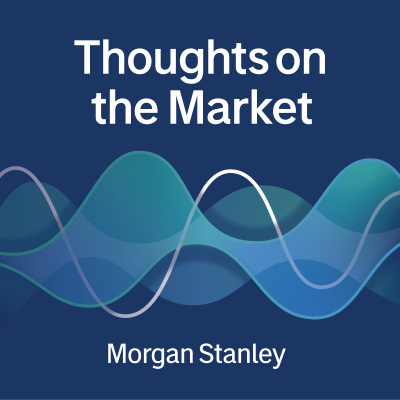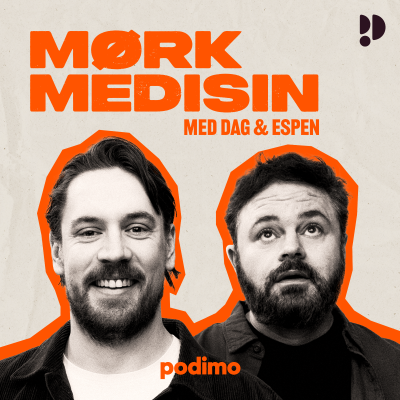
Thoughts on the Market
engelsk
Business
Prøv gratis i 0 days. 99 kr / Måned etter prøveperioden. Avslutt når som helst.
Mer enn 1 million lyttere
Du vil elske Podimo, og du er ikke alene
Vurdert til 4,7 stjerner i App Store

Les mer Thoughts on the Market
Short, thoughtful and regular takes on recent events in the markets from a variety of perspectives and voices within Morgan Stanley.
Alle episoder
1506 Episoder2026 Global Outlook: A Strong Year for Risk Assets
Our Chief Global Economist Seth Carpenter and Global Cross-Asset Strategist Serena Tang return to conclude their two-part episode on 2026 outlooks and explain why the market environment is turning in favor of risk assets, especially U.S. stocks. Read more insights [https://www.morganstanley.com/insights?cid=mg-SM_CORP-insights-17607] from Morgan Stanley. ----- Transcript ----- Seth Carpenter: Welcome to Thoughts in the Market. I'm Seth Carpenter, Morgan Stanley's Global Chief Economist. Serena Tang: And I'm Serena Tang, Morgan Stanley's Chief Global Cross-Asset Strategist. Seth Carpenter: Yesterday, Serena, we discussed our views on the global economy, and today I'm going to turn the tables on you and start asking you questions about our market outlook and how to invest across regions and across asset classes. It's Tuesday, November 18th at 10am in New York. Alright, Serena in 2025, global markets rode some significant volatility driven by tariffs, policy uncertainty. Things went up, they went down. Equities ultimately outperformed bonds as rate cuts began. But cross-asset strategy depended so much on identifying correlations, opportunities – all in a world that is still adapting to the new geopolitical dynamics and what seemed like evolving rules. So, with that backdrop, could you just broadly tell us what the investment strategy should be in 2026? Serena Tang: We think 2026 will be a strong year for risk assets as you have unusually pro-cyclical policy mix that's supportive of earnings. And that frees up markets to shift the focus from global macro concerns, which of course have dominated this year, to more micro asset specific narratives. Particularly those related to AI CapEx investment. And I think such a constructive environment really calls for a risk on tilt. We recommend equities over credit and government bonds, with a preference for U.S. assets. Seth Carpenter: Okay. I think last year we had some preference, at least for U.S. equities. Are there any other big rotations versus more of the same that you really want to highlight for folks? Serena Tang: In terms of, I think the strategy outlook itself, a big shift has been what we think drive investor focus the most. Our strategy mid-year outlook had focused heavily on global macro risks, right? Especially those, I think, emanated from trade tensions, which you alluded to earlier. I think this time around as the distribution of outcomes on tariffs, I think, has become a bit narrower, it's very much more about asset specific stories. And yes, you know, to your point about being, bullish on U.S. equities, we've maintained that view this time round and believe that U.S. equities can generally do better than rest of world. As you know, Mike Wilson, a colleague and chief U.S. equity strategist, he has a price target of 7800 for the S&P 500 index … Seth Carpenter: Wow. Serena Tang: Beating the expected returns from other regional equities by like quite a bit. So that's not changed. But I think that with this backdrop of post cyclical policy combo lifting U.S. earnings, we've also turned more bullish on high-yield corporate credit – that is bonds which are riskier. I think very much like U.S. equities, we believe that the asset class can benefit from the combination of monetary deregulation policy. But there's also like a very interesting technical component there, which is, as we expect, a surge in investment grade issuance to fund AI related CapEx. I think the high-yield market will be more insulated from this, which means outperformance versus higher quality corporate bonds. Seth Carpenter: Got it. Okay. So, as you're coming up with these strategies and these recommendations in lots of ways, it just relies on forecasting. And I have to say I'm sympathetic to how hard forecasting is, especially when it comes to the future. In our economic forecast, we also included a bunch of different alternate scenarios because I just see that much uncertainty in the global economy. So, with that as a backdrop, nothing is for sure. But where would you say your highest conviction calls are when it comes to investing in 2026? Serena Tang: Well, as I mentioned, we like U.S. equities and that remains a very high conviction call for us. [I] sort of dug through the details of that already. And so, I want to turn to a[n]other high conviction view, which is curve steepening. We see pretty material U.S. treasury curve steepening over the next year. I think even as a macro strategist, actually expect yields at least in the backend to be mostly range bound. And this steepening will be very much driven by what happens in the two-year point – I think as markets continue to, we think, underpriced, future Fed easing and growth slow down tail risks. Seth Carpenter: So that's super helpful in terms of the places where you're convicted. Let me be perhaps a little bit unfair because nothing is in fact certain. And so, if there are things that we feel pretty sure about, there've got to be things where we're either not sure or parts of the market that really pose the most risk. So, if I asked you then, where do you see the biggest risk for investors in markets next year, what would you say? Serena Tang: So, one of them really is AI investment cycle abruptly ending. And this has been a topic of huge debate in all of the investor meetings that we've had over the last several weeks. Because the idea is you have a sharp pullback in investment in the next 12 months, which could trigger a pretty cascading effect. And of course that would likely pressure U.S. equities, I think given hyperscalers index weight. But could weirdly enough benefit IG credit by reducing issuance, which has been the main driver of wider spreads in our forecast. But I think the other risk here actually is if animal spirits run a bit too hot. Underlying our equities over credit over rates allocation is some revival in animal spirits, but it's not the kind of irrational exuberance that marks the end of cycle in our view. Given, I think there's still rational belief in that policy triumvirate that we touched on earlier, that can still be supportive of risk. But you know, I think if sentiment does overheat then our allocation tilt towards cyclicals and beta would be wrong. And historically late cycle expansions see investment grade outperforming high yield inequities, with bonds eventually leading returns. The last risk, I think, to our asset allocation, is really the Fed. Either the FOMC not easing further over the next 12 months or if it changes its reaction function. And I think both of those will have very different implications of what happens to the front end of the yield curve. So, my question to you, Seth, is what do you see as the probability around both of those scenarios? Seth Carpenter: Look, with the data that we have before the government shut down, it was clear there was a tension. Spending by households, spending by businesses was strong. Employment data were getting weaker and weaker, and the Fed has decided to start cutting to err on the side of insulating against further deterioration in the labor market. So, one thing that could upend our forecast is that the real signal is from the spending. Spending stays strong, the labor market eventually catches up to the stronger spending, and we start to see job gains come back. If that happens, especially with inflation now running notably above the Fed's target, I just don't really think we're going to get anywhere near the number of rate cuts that we forecast or that are already priced into market. So, you'd have to see a reversal. How likely is that you can't rule it out? I'd say 20 percent or something like that. Maybe a little bit more. On the other hand, to the downside. I wonder if what you're getting at a little bit is there's going to be some turnover in the personnel at the Fed. And do we have to worry about a fundamentally different reaction function from the Fed going forward and cutting rates aggressively, even if the macro considerations don't warrant? Is that really what you were getting at? Serena Tang: Yes. I think that has been the question on the forefront of investors' minds… Seth Carpenter: Yeah, I think that's a real question. The way I look at it is Chair Powell is in charge of the Fed now. His term goes through May of next year. And so, until we get to the middle of next year, I don't really think there's any fundamental change in how the Fed does business. But it really does seem like we're going to have a new Fed chair in June of next year. But even there, we have got to remember that the committee is a committee and that's how policy is decided. And so, if there was a new chair who really, really, really wanted to take policy in a truly unorthodox way, I also don't think that's really feasible over the second half of next year – because there just won't have been that much turnover in terms of the personnel of the Fed. That's how we're looking at it for now. I really don't think that latter version of the world is a big risk. That said, I'm going to throw it back to you [be]cause I always have to get the last word. You talked about asset classes, bullish on U.S. equities. We talked about high yield bonds; we talked about some of the risks that markets have to face. But one thing I didn't hear – and we do have a global investor base – Is about currencies and specifically the dollar. So, this time last year, the team made a pretty bold call that the dollar would depreciate a great deal. And here we are and the dollar has come off a lot on net over this year. That stabilized a little bit. Maybe not for the whole year [be]cause that kind of forecasting is hard for currencies. But what do you see over the next few months called the next half year for the dollar? Is it going to continue the trend or do you think we should see a reversal? Serena Tang: So, we do think the dollar will continue its trend downwards from here to the middle of next year. And I know, I know. There's been a lot of discussion, there's been a lot of debate around whether the dollar has basically stopped where we are. But the thing is, you know, going back to what you mentioned around the path for growth in the U.S. and unemployment in the U.S. – if we do see softer economic data in the first half of next year, that can drive the dollar downwards. In fact, we're once again, more bearish than consensus on the dollar by the middle of next year. Seth Carpenter: Got it. All right. That's super helpful. Serena, thank you so much for taking the time to talk with me today and let me ask the questions of you. Serena Tang: Always a pleasure, Seth. Seth Carpenter: And thank you for listening. If you enjoy Thoughts on the Market, please leave us a review wherever you listen and share the podcast with a friend or a colleague today.
2026 Global Outlook: Slower Growth and Inflation
In the first of a two-part episode presenting our 2026 outlooks, Chief Global Cross-Asset Strategist Serena Tang has Chief Global Economist Seth Carpenter explain his thoughts on how economies around the world are expected to perform and how central banks may respond. Read more insights [https://www.morganstanley.com/insights?cid=mg-SM_CORP-insights-17607] from Morgan Stanley. ----- Transcript ----- Serena Tang: Welcome to Thoughts on the Market. I'm Serena Tang, Morgan Stanley's Chief Global Cross-Asset Strategist. Seth Carpenter: And I'm Seth Carpenter, Morgan Stanley's Global Chief Economist. Serena Tang: So today and tomorrow, a two-part conversation on Morgan Stanley's year ahead outlook. Today, we'll focus on the all-important macroeconomic backdrop. And tomorrow, we'll be back with our views on investing across asset classes and markets. Serena Tang: It's Monday, November 17th at 10am in New York. So, Seth, 2025 has been a year of transition. Global growth slowed under the weight of tariffs and policy uncertainty. Yet resilience in consumer spending and AI driven investments kept recession fears at bay. Your team has published its economic outlook for 2026. So, what's your view on global growth for the year ahead? Seth Carpenter: We really think next year is going to be the global economy slowing down a little bit more just like it did this year, settling into a slower growth rate. But at the same time, we think inflation is going to keep drifting down in most of the world. Now that anodyne view, though, masks some heterogeneity around the world; and importantly, some real uncertainty about different ways things could possibly go. Here in the U.S., we think there is more slowing to come in the near term, especially the fourth quarter of this year and the beginning of next year. But once the economy works its way through the tariffs, maybe some of the lagged effects of monetary policy, we'll start to see things pick up a bit in the second half of the year. China's a different story. We see the really tepid growth there pushed down by the deflationary spiral they've been in. We think that continues for next year, and so they're probably not quite going to get to their 5 percent growth target. And in Europe, there's this push and pull of fiscal policy across the continent. There's a central bank that thinks they've achieved their job in terms of inflation, but overall, we think growth there is, kind of, unremarkable, a little bit over 1 percent. Not bad, but nothing to write home about at all. So that's where we think things are going in general. But I have to say next year, may well be a year for surprises. Serena Tang: Right. So where do you see the biggest drivers of global growth in 2026, and what are some of the key downside risks? Seth Carpenter: That's a great question. I really do think that the U.S. is going to be a real key driver of the story here. And in fact – and maybe we'll talk about this later – if we're wrong, there's some upside scenarios, there's some downside scenarios. But most of them around the world are going to come from the U.S. Two things are going on right now in the U.S. We've had strong spending data. We've also had very, very weak employment data. That usually doesn't last for very long. And so that's why we think in the near term there's some slowdown in the U.S. and then over time things recover. We could be wrong in either direction. And so, if we're wrong and the labor market sending the real signal, then the downside risk to the U.S. economy – and by extension the global economy – really is a recession in the U.S. Now, given the starting point, given how low unemployment is, given the spending businesses are doing for AI, if we did get that recession, it would be mild. On the other hand, like I said, spending is strong. Business spending, especially CapEx for AI; household spending, especially at the top end of the income distribution where wealth is rising from stocks, where the liability side of the balance sheet is insulated with fixed rate mortgages. That spending could just stay strong, and we might see this upside surprise where the spending really dominates the scene. And again, that would spill over for the rest of the world. What I don't see is a lot of reason to suspect that you're going to get a big breakout next year to the upside or the downside from either Europe or China, relative to our baseline scenarios. It could happen, but I really think most of the story is going to be driven in the U.S. Serena Tang: So, Seth, markets have been focused on the Fed, as it should. What is the likely path in 2026 and how are you thinking about central bank policy in general in other regions? Seth Carpenter: Absolutely. The Fed is always of central importance to most people in markets. Our view – and the market's view, I have to say, has been evolving here. Our view is that the Fed's actually got a few more rate cuts to get through, and that by the time we get to the middle of next year, the middle of 2026, they're going to have their policy rate down just a little bit above 3 percent. So roughly where the committee thinks neutral is. Why do we think that? I think the slowing in the labor market that we talked about before, we think there's something kind of durable there. And now that the government shutdown has ended and we're going to start to get regular data prints again, we think the data are going to show that job creation has been below 50,000 per month on average, and maybe even a few of them are going to get to be negative over the next several months. In that situation, we think the Fed's going to get more inclination to guard against further deterioration in the labor market by keeping cutting rates and making sure that the central bank is not putting any restraint on the economy. That's similar, I would say, to a lot of other developed markets’ central banks. But the tension for the ECB, for example, is that President Lagarde has said she thinks; she thinks the disinflationary process is over. She thinks sitting at 2 percent for the policy rate, which the ECB thinks of as neutral, then that's the right place for them to be. Our take though is that the data are going to push them in a different direction. We think there is clearly growth in Europe, but we think it's tepid. And as a result, the disinflationary process has really still got some more room to run and that inflation will undershoot their 2 percent target, and as a result, the ECB is probably going to cut again. And in our view, down to about 1.5 percent. Big difference is in Japan. Japan is the developed market central bank that's hiking. Now, when does that happen? Our best guess is next month in December at the policy meeting. We've seen this shift towards reflation. It hasn't been smooth, hasn't been perfectly linear. But the BoJ looks like they're set to raise rates again in December. But the path for inflation is going to be a bit rocky, and so, they're probably on hold for most of 2026. But we do think eventually, maybe not till 2027, they get back to hiking again – so that Governor Ueda can get the policy rate back close to neutral before he steps down. Serena Tang: So, one of the main investor debates is on AI. Whether it's CapEx, productivity, the future of work. How is that factoring into your team's view on growth and inflation for the next year? Seth Carpenter: Yeah, I mean that is absolutely a key question that we get all the time from investors around the world. When I think about AI and how it's affecting the economy, I think about the demand side of the economy, and that's where you think about this CapEx spending – building data centers, buying semiconductors, that sort of thing. That's demand in the economy. It's using up current resources in the economy, and it's got to be somewhat inflationary. It's part of what has kept the U.S. economy buoyant and resilient this year – is that CapEx spending. Now you also mentioned productivity, and for me, that's on the supply side of the economy. That's after the technology is in place. After firms have started to adopt the technology, they're able to produce either the same amount with fewer workers, or they're able to produce more with the same amount of workers. Either way, that's what productivity means, and it's on the supply side. It can mean faster growth and less inflation. I think where we are for 2026, and it's important that we focus it on the near term, is the demand side is much more important than the supply side. So, we think growth continues. It's supported by this business investment spending. But we still think inflation ends 2026, notably above the Fed's inflation target. And it's going to make five, five and a half years that we've been above target. Productivity should kick in. And we've written down something close to a quarter percentage point of extra productivity growth for 2026, but not enough to really be super disinflationary. We think that builds over time, probably takes a couple of years. And for example, if we think about some of the announcements about these data centers that are being built, where they're really going to unleash the potential of AI, those aren't going to be completed for a couple of years anyway. So, I think for now, AI is dominating the demand side of the economy. Over the next few years, it's going to be a real boost to the supply side of the economy. Serena Tang: So that makes a lot of sense to me, Seth. But can you put those into numbers? Seth Carpenter: Sure, Serena totally. In numbers, that's about 3 percent growth. A little bit more than that for global GDP growth on like a Q4-over-Q4 basis. But for the U.S. in particular, we've got about 1.75 percent. So that's not appreciably different from what we're looking for this year in 2025. But the number really, kind of, masks the evolution over time. We think the front part of the year is going to be much weaker. And only once we get into the second half of next year will things start to pick up. That said, compared to where we were when we did the midyear outlook, it's actually a notable upgrade. We've taken real signal from the fact that business spending, household spending have both been stronger than we think. And we've tried to add in just a little bit more in terms of productivity growth from AI. Layer on top of that, the Fed who's been clearly willing to start to ease interest rates sooner than we thought at the time of the mid-year outlook – all comes together for a little bit better outlook for growth for 2026 in the U.S. Serena Tang: Seth thanks so much for taking the time to talk. Seth Carpenter: Serena, it is always my pleasure to get to talk to you. Serena Tang: And thanks for listening. Please be sure to tune into the second half of our conversation tomorrow to hear how we're thinking about investment strategy in the year ahead. If you enjoy Thoughts on the Market, please leave us a review wherever you listen and share the podcast with a friend or colleague today.
2026 Midterm Elections: What’s at Stake for Markets
Michael Zezas, our Global Head of Fixed Income Research and Public Policy Strategy, highlights what investors need to watch out for ahead of next year’s U.S. congressional elections. Read more insights [https://www.morganstanley.com/insights?cid=mg-SM_CORP-insights-17607] from Morgan Stanley. ----- Transcript ----- Welcome to Thoughts on the Market. I’m Michael Zezas, Global Head of Fixed Income Research and Public Policy Strategy. Today, we’re tackling a question that’s top of mind after last week’s off-cycle elections in New Jersey, New York, Virginia, and California: What could next year’s midterm elections mean for investors, especially if Democrats take control of Congress? It’s Friday, Nov 14th at 10:30am in New York. In last week's elections, Democrats outperformed expectations. In California, a new redistricting measure could flip several house seats; and in New Jersey and Virginia Democrat candidates, won with meaningfully higher margins than polls suggested was likely. As such prediction markets now give Democrats a roughly 70 percent chance of winning the House next year. But before we jump to conclusions, let’s pump the brakes. It might not be too early to think about the midterms as a market catalyst. We’ll be doing plenty of that. But we think it's too early to strategize around it. Why? First, a lot can change—both in terms of likely outcomes and the issues driving the electorate. While Democrats are favored today, redistricting, turnout, and evolving voter concerns could reshape the landscape in the months to come. Second, even if Democrats take control of the House, it may not change the trajectory of the policies that matter most to market pricing. In our view, Republicans already achieved their main legislative goals through the tax and fiscal bill earlier this year. The other market-moving policy shifts this year—think tariffs and regulatory changes—have come through executive action, not legislation. The administration has leaned heavily on executive powers to set trade policy, including the so-called Liberation Day tariffs, and to push regulatory changes. Future potential moves investors are watching, like additional regulation or targeted stimulus, would likely come the same way. Meanwhile, the plausible Republican legislative agenda—like further tax cuts—would face steep hurdles. Any majority would be slim, and fiscal hawks in the party nearly blocked the last round of cuts due to concerns over spending offsets. Moderates, for their part, are unlikely to tolerate deeper cuts, especially after the contentious debate over Medicaid in the OBBBA (One Big Beautiful Bill Act). So, what could change this view? If we’re wrong, it’s likely because the economy slows and tips into recession, making fiscal stimulus more politically appealing—consistent with historical patterns. Or, Democrats could win so decisively on economic and affordability issues that the White House considers standalone stimulus measures, like reducing some tariffs. How does this all connect to markets? For U.S. equities, the current policy mix—industrial incentives, tax cuts, and AI-driven capex—has supported risk assets and driven opportunities in sectors like technology and manufacturing. But it also means that, looking deeper into next year, if growth disappoints, fiscal concerns could emerge as a risk factor challenging the market. There doesn’t appear an obvious political setup to shift policies to deal with elevated U.S. deficits, meaning the burden is on better growth to deal with this issue. Thanks for listening. If you enjoy Thoughts on the Market, please leave us a review and share the podcast. We’ll keep you updated as the story unfolds.
Who’s Disrupting — and Funding — the AI Boom
Live from Morgan Stanley’s European Tech, Media and Telecom Conference in Barcelona, our roundtable of analysts discusses tech disruptions and datacenter growth, and how Europe factors in. Read more insights [https://www.morganstanley.com/insights?cid=mg-SM_CORP-insights-17607] from Morgan Stanley. ----- Transcript ----- Paul Walsh: Welcome to Thoughts on the Market. I'm Paul Walsh, Morgan Stanley's European Head of Research Product. Today we return to my conversation with Adam Wood. Head of European Technology and Payments, Emmet Kelly, Head of European Telco and Data Centers, and Lee Simpson, Head of European Technology. We were live on stage at Morgan Stanley's 25th TMT Europe conference. We had so much to discuss around the themes of AI enablers, semiconductors, and telcos. So, we are back with a concluding episode on tech disruption and data center investments. It's Thursday the 13th of November at 8am in Barcelona. After speaking with the panel about the U.S. being overweight AI enablers, and the pockets of opportunity in Europe, I wanted to ask them about AI disruption, which has been a key theme here in Europe. I started by asking Adam how he was thinking about this theme. Adam Wood: It’s fascinating to see this year how we've gone in most of those sectors to how positive can GenAI be for these companies? How well are they going to monetize the opportunities? How much are they going to take advantage internally to take their own margins up? To flipping in the second half of the year, mainly to, how disruptive are they going to be? And how on earth are they going to fend off these challenges? Paul Walsh: And I think that speaks to the extent to which, as a theme, this has really, you know, built momentum. Adam Wood: Absolutely. And I mean, look, I think the first point, you know, that you made is absolutely correct – that it's very difficult to disprove this. It's going to take time for that to happen. It's impossible to do in the short term. I think the other issue is that what we've seen is – if we look at the revenues of some of the companies, you know, and huge investments going in there. And investors can clearly see the benefit of GenAI. And so investors are right to ask the question, well, where's the revenue for these businesses? You know, where are we seeing it in info services or in IT services, or in enterprise software. And the reality is today, you know, we're not seeing it. And it's hard for analysts to point to evidence that – well, no, here's the revenue base, here's the benefit that's coming through. And so, investors naturally flip to, well, if there's no benefit, then surely, we should focus on the risk. So, I think we totally understand, you know, why people are focused on the negative side of things today. I think there are differences between the sub-sectors. I mean, I think if we look, you know, at IT services, first of all, from an investor point of view, I think that's been pretty well placed in the losers’ buckets and people are most concerned about that sub-sector… Paul Walsh: Something you and the global team have written a lot about. Adam Wood: Yeah, we've written about, you know, the risk of disruption in that space, the need for those companies to invest, and then the challenges they face. But I mean, if we just keep it very, very simplistic. If Gen AI is a technology that, you know, displaces labor to any extent – companies that have played labor arbitrage and provide labor for the last 20 - 25 years, you know, they're going to have to make changes to their business model. So, I think that's understandable. And they're going to have to demonstrate how they can change and invest and produce a business model that addresses those concerns. I'd probably put info services in the middle. But the challenge in that space is you have real identifiable companies that have emerged, that have a revenue base and that are challenging a subset of the products of those businesses. So again, it's perfectly understandable that investors would worry. In that context, it's not a potential threat on the horizon. It's a real threat that exists today against certainly their businesses. I think software is probably the most interesting. I'd put it in the kind of final bucket where I actually believe… Well, I think first of all, we certainly wouldn't take the view that there's no risk of disruption and things aren't going to change. Clearly that is going to be the case. I think what we'd want to do though is we'd want to continue to use frameworks that we've used historically to think about how software companies differentiate themselves, what the barriers to entry are. We don't think we need to throw all of those things away just because we have GenAI, this new set of capabilities. And I think investors will come back most easily to that space. Paul Walsh: Emett, you talked a little bit there before about the fact that you haven't seen a huge amount of progress or additional insight from the telco space around AI; how AI is diffusing across the space. Do you get any discussions around disruption as it relates to telco space? Emmet Kelly: Very, very little. I think the biggest threat that telcos do see is – it is from the hyperscalers. So, if I look at and separate the B2C market out from the B2B, the telcos are still extremely dominant in the B2C space, clearly. But on the B2B space, the hyperscalers have come in on the cloud side, and if you look at their market share, they're very, very dominant in cloud – certainly from a wholesale perspective. So, if you look at the cloud market shares of the big three hyperscalers in Europe, this number is courtesy of my colleague George Webb. He said it's roughly 85 percent; that's how much they have of the cloud space today. The telcos, what they're doing is they're actually reselling the hyperscale service under the telco brand name. But we don't see much really in terms of the pure kind of AI disruption, but there are concerns definitely within the telco space that the hyperscalers might try and move from the B2B space into the B2C space at some stage. And whether it's through virtual networks, cloudified networks, to try and get into the B2C space that way. Paul Walsh: Understood. And Lee maybe less about disruption, but certainly adoption, some insights from your side around adoption across the tech hardware space? Lee Simpson: Sure. I think, you know, it's always seen that are enabling the AI move, but, but there is adoption inside semis companies as well, and I think I'd point to design flow. So, if you look at the design guys, they're embracing the agentic system thing really quickly and they're putting forward this capability of an agent engineer, so like a digital engineer. And it – I guess we've got to get this right. It is going to enable a faster time to market for the design flow on a chip. So, if you have that design flow time, that time to market. So, you're creating double the value there for the client. Do you share that 50-50 with them? So, the challenge is going to be exactly as Adam was saying, how do you monetize this stuff? So, this is kind of the struggle that we're seeing in adoption. Paul Walsh: And Emmett, let's move to you on data centers. I mean, there are just some incredible numbers that we've seen emerging, as it relates to the hyperscaler investment that we're seeing in building out the infrastructure. I know data centers is something that you have focused tremendously on in your research, bringing our global perspectives together. Obviously, Europe sits within that. And there is a market here in Europe that might be more challenged. But I'm interested to understand how you're thinking about framing the whole data center story? Implications for Europe. Do European companies feed off some of that U.S. hyperscaler CapEx? How should we be thinking about that through the European lens? Emmet Kelly: Yeah, absolutely. So, big question, Paul. What… Paul Walsh: We've got a few minutes! Emmet Kelly: We've got a few minutes. What I would say is there was a great paper that came out from Harvard just two weeks ago, and they were looking at the scale of data center investments in the United States. And clearly the U.S. economy is ticking along very, very nicely at the moment. But this Harvard paper concluded that if you take out data center investments, U.S. economic growth today is actually zero. Paul Walsh: Wow. Emmet Kelly: That is how big the data center investments are. And what we've said in our research very clearly is if you want to build a megawatt of data center capacity that's going to cost you roughly $35 million today. Let's put that number out there. 35 million. Roughly, I'd say 25… Well, 20 to 25 million of that goes into the chips. But what's really interesting is the other remaining $10 million per megawatt, and I like to call that the picks and shovels of data centers; and I'm very convinced there is no bubble in that area whatsoever. So, what's in that area? Firstly, the first building block of a data center is finding a powered land bank. And this is a big thing that private equity is doing at the moment. So, find some real estate that's close to a mass population that's got a good fiber connection. Probably needs a little bit of water, but most importantly needs some power. And the demand for that is still infinite at the moment. Then beyond that, you've got the construction angle and there's a very big shortage of labor today to build the shells of these data centers. Then the third layer is the likes of capital goods, and there are serious supply bottlenecks there as well. And I could go on and on, but roughly that first $10 million, there's no bubble there. I'm very, very sure of that. Paul Walsh: And we conducted some extensive survey work recently as part of your analysis into the global data center market. You've sort of touched on a few of the gating factors that the industry has to contend with. That survey work was done on the operators and the supply chain, as it relates to data center build out. What were the key conclusions from that? Emmet Kelly: Well, the key conclusion was there is a shortage of power for these data centers, and… Paul Walsh: Which I think… Which is a sort of known-known, to some extent. Emmet Kelly: it is a known-known, but it's not just about the availability of power, it's the availability of green power. And it's also the price of power is a very big factor as well because energy is roughly 40 to 45 percent of the operating cost of running a data center. So, it's very, very important. And of course, that's another area where Europe doesn't screen very well. I was looking at statistics just last week on the countries that have got the highest power prices in the world. And unsurprisingly, it came out as UK, Ireland, Germany, and that's three of our big five data center markets. But when I looked at our data center stats at the beginning of the year, to put a bit of context into where we are… Paul Walsh: In Europe… Emmet Kelly: In Europe versus the rest. So, at the end of [20]24, the U.S. data center market had 35 gigawatts of data center capacity. But that grew last year at a clip of 30 percent. China had a data center bank of roughly 22 gigawatts, but that had grown at a rate of just 10 percent. And that was because of the chip issue. And then Europe has capacity, or had capacity at the end of last year, roughly 7 to 8 gigawatts, and that had grown at a rate of 10 percent. Now, the reason for that is because the three big data center markets in Europe are called FLAP-D. So, it's Frankfurt, London, Amsterdam, Paris, and Dublin. We had to put an acronym on it. So, Flap-D. Good news. I'm sitting with the tech guys. They've got even more acronyms than I do, in their sector, so well done them. Lee Simpson: Nothing beats FLAP-D. Paul Walsh: Yes. Emmet Kelly: It’s quite an achievement. But what is interesting is three of the big five markets in Europe are constrained. So, Frankfurt, post the Ukraine conflict. Ireland, because in Ireland, an incredible statistic is data centers are using 25 percent of the Irish power grid. Compared to a global average of 3 percent. Now I'm from Dublin, and data centers are running into conflict with industry, with housing estates. Data centers are using 45 percent of the Dublin grid, 45. So, there's a moratorium in building data centers there. And then Amsterdam has the classic semi moratorium space because it's a small country with a very high population. So, three of our five markets are constrained in Europe. What is interesting is it started with the former Prime Minister Rishi Sunak. The UK has made great strides at attracting data center money and AI capital into the UK and the current Prime Minister continues to do that. So, the UK has definitely gone; moved from the middle lane into the fast lane. And then Macron in France. He hosted an AI summit back in February and he attracted over a 100 billion euros of AI and data center commitments. Paul Walsh: And I think if we added up, as per the research that we published a few months ago, Europe's announced over 350 billion euros, in proposed investments around AI. Emmet Kelly: Yeah, absolutely. It's a good stat. Now where people can get a little bit cynical is they can say a couple of things. Firstly, it's now over a year since the Mario Draghi report came out. And what's changed since? Absolutely nothing, unfortunately. And secondly, when I look at powering AI, I like to compare Europe to what's happening in the United States. I mean, the U.S. is giving access to nuclear power to AI. It started with the three Mile Island… Paul Walsh: Yeah. The nuclear renaissance is… Emmet Kelly: Nuclear Renaissance is absolutely huge. Now, what's underappreciated is actually Europe has got a massive nuclear power bank. It's right up there. But unfortunately, we're decommissioning some of our nuclear power around Europe, so we're going the wrong way from that perspective. Whereas President Trump is opening up the nuclear power to AI tech companies and data centers. Then over in the States we also have gas and turbines. That's a very, very big growth area and we're not quite on top of that here in Europe. So, looking at this year, I have a feeling that the Americans will probably increase their data center capacity somewhere between – it's incredible – somewhere between 35 and 50 percent. And I think in Europe we're probably looking at something like 10 percent again. Paul Walsh: Okay. Understood. Emmet Kelly: So, we're growing in Europe, but we're way, way behind as a starting point. And it feels like the others are pulling away. The other big change I'd highlight is the Chinese are really going to accelerate their data center growth this year as well. They've got their act together and you'll see them heading probably towards 30 gigs of capacity by the end of next year. Paul Walsh: Alright, we're out of time. The TMT Edge is alive and kicking in Europe. I want to thank Emmett, Lee and Adam for their time and I just want to wish everybody a great day today. Thank you. (Applause) That was my conversation with Adam, Emmett and Lee. Many thanks again to them. Many thanks again to them for telling us about the latest in their areas of research and to the live audience for hearing us out. And a thanks to you as well for listening. Let us know what you think about this and other episodes by living us a review wherever you get your podcasts. And if you enjoy listening to Thoughts on the Market, please tell a friend or colleague about the podcast today.
Europe in the Global AI Race
Live from Morgan Stanley’s European Tech, Media and Telecom conference in Barcelona, our roundtable of analysts discuss artificial intelligence in Europe, and how the region could enable the Agentic AI wave. Read more insights [https://www.morganstanley.com/insights?cid=mg-SM_CORP-insights-17607] from Morgan Stanley. ----- Transcript ----- Paul Walsh: Welcome to Thoughts on the Market. I'm Paul Walsh, Morgan Stanley's European head of research product. We are bringing you a special episode today live from Morgan Stanley's, 25th European TMT Conference, currently underway. The central theme we're focused on: Can Europe keep up from a technology development perspective? It's Wednesday, November the 12th at 8:00 AM in Barcelona. Earlier this morning I was live on stage with my colleagues, Adam Wood, Head of European Technology and Payments, Emmet Kelly, Head of European Telco and Data Centers, and Lee Simpson, Head of European Technology Hardware. The larger context of our conversation was tech diffusion, one of our four key themes that we've identified at Morgan Stanley Research for 2025. For the panel, we wanted to focus further on agentic AI in Europe, AI disruption as well as adoption, and data centers. We started off with my question to Adam. I asked him to frame our conversation around how Europe is enabling the Agentic AI wave. Adam Wood: I mean, I think obviously the debate around GenAI, and particularly enterprise software, my space has changed quite a lot over the last three to four months. Maybe it's good if we do go back a little bit to the period before that – when everything was more positive in the world. And I think it is important to think about, you know, why we were excited, before we started to debate the outcomes. And the reason we were excited was we've obviously done a lot of work with enterprise software to automate business processes. That's what; that's ultimately what software is about. It's about automating and standardizing business processes. They can be done more efficiently and more repeatably. We'd done work in the past on RPA vendors who tried to take the automation further. And we were getting numbers that, you know, 30 – 40 percent of enterprise processes have been automated in this way. But I think the feeling was it was still the minority. And the reason for that was it was quite difficult with traditional coding techniques to go a lot further. You know, if you take the call center as a classic example, it's very difficult to code what every response is going to be to human interaction with a call center worker. It's practically impossible. And so, you know, what we did for a long time was more – where we got into those situations where it was difficult to code every outcome, we'd leave it with labor. And we'd do the labor arbitrage often, where we'd move from onshore workers to offshore workers, but we'd still leave it as a relatively manual process with human intervention in it. I think the really exciting thing about GenAI is it completely transforms that equation because if the computers can understand natural human language, again to our call center example, we can train the models on every call center interaction. And then first of all, we can help the call center worker predict what the responses are going to be to incoming queries. And then maybe over time we can even automate that role. I think it goes a lot further than, you know, call center workers. We can go into finance where a lot of work is still either manual data re-entry or a remediation of errors. And again, we can automate a lot more of those tasks. That's obviously where, where SAP's involved. But basically what I'm trying to say is if we expand massively the capabilities of what software can automate, surely that has to be good for the software sector that has to expand the addressable markets of what software companies are going to be able to do. Now we can have a secondary debate around: Is it going to be the incumbents, is it going to be corporates that do more themselves? Is it going to be new entrants that that benefit from this? But I think it's very hard to argue that if you expand dramatically the capabilities of what software can do, you don't get a benefit from that in the sector. Now we're a little bit more consumer today in terms of spending, and the enterprises are lagging a little bit. But I think for us, that's just a question of timing. And we think we'll see that come through. I'll leave it there. But I think there's lots of opportunities in software. We're probably yet to see them come through in numbers, but that shouldn't mean we get, you know, kind of, we don't think they're going to happen. Paul Walsh: Yeah. We’re going to talk separately about AI disruption as we go through this morning's discussion. But what's the pushback you get, Adam, to this notion of, you know, the addressable market expanding? Adam Wood: It's one of a number of things. It's that… And we get onto the kind of the multiple bear cases that come up on enterprise software. It would be some combination of, well, if coding becomes dramatically cheaper and we can set up, you know, user interfaces on the fly in the morning, that can query data sets; and we can access those data sets almost in an automated way. Well, maybe companies just do this themselves and we move from a world where we've been outsourcing software to third party software vendors; we do more of it in-house. That would be one. The other one would be the barriers to entry of software have just come down dramatically. It's so much easier to write the code, to build a software company and to get out into the market. That it's going to be new entrants that challenge the incumbents. And that will just bring price pressure on the whole market and bring… So, although what we automate gets bigger, the price we charge to do it comes down. The third one would be the seat-based pricing issue that a lot of software vendors to date have expressed the value they deliver to customers through. How many seats of the software you have in house. Well, if we take out 10 – 20 percent of your HR department because we make them 10, 20, 30 percent more efficient. Does that mean we pay the software vendor 10, 20, 30 percent less? And so again, we're delivering more value, we're automating more and making companies more efficient. But the value doesn't accrue to the software vendors. It's some combination of those themes I think that people would worry about. Paul Walsh: And Lee, let’s bring you into the conversation here as well, because around this theme of enabling the agentic AI way, we sort of identified three main enabler sectors. Obviously, Adam’s with the software side. Cap goods being the other one that we mentioned in the work that we've done. But obviously semis is also an important piece of this puzzle. Walk us through your thoughts, please. Lee Simpson: Sure. I think from a sort of a hardware perspective, and really we're talking about semiconductors here and possibly even just the equipment guys, specifically – when seeing things through a European lens. It's been a bonanza. We've seen quite a big build out obviously for GPUs. We've seen incredible new server architectures going into the cloud. And now we're at the point where we're changing things a little bit. Does the power architecture need to be changed? Does the nature of the compute need to change? And with that, the development and the supply needs to move with that as well. So, we're now seeing the mantle being picked up by the AI guys at the very leading edge of logic. So, someone has to put the equipment in the ground, and the equipment guys are being leaned into. And you're starting to see that change in the order book now. Now, I labor this point largely because, you know, we'd been seen as laggards frankly in the last couple of years. It'd been a U.S. story, a GPU heavy story. But I think for us now we're starting to see a flipping of that and it's like, hold on, these are beneficiaries. And I really think it's 'cause that bow wave has changed in logic. Paul Walsh: And Lee, you talked there in your opening remarks about the extent to which obviously the focus has been predominantly on the U.S. ways to play, which is totally understandable for global investors. And obviously this has been an extraordinary year of ups and downs as it relates to the tech space. What's your sense in terms of what you are getting back from clients? Is the focus shifts may be from some of those U.S. ways to play to Europe? Are you sensing that shift taking place? How are clients interacting with you as it relates to the focus between the opportunities in the U.S. and Asia, frankly, versus Europe? Lee Simpson: Yeah. I mean, Europe's coming more into debate. It's more; people are willing to talk to some of the players. We've got other players in the analog space playing into that as well. But I think for me, if we take a step back and keep this at the global level, there's a huge debate now around what is the size of build out that we need for AI? What is the nature of the compute? What is the power pool? What is the power budgets going to look like in data centers? And Emmet will talk to that as well. So, all of that… Some of that argument’s coming now and centering on Europe. How do they play into this? But for me, most of what we're finding people debate about – is a 20-25 gigawatt year feasible for [20]27? Is a 30-35 gigawatt for [20]28 feasible? And so, I think that's the debate line at this point – not so much as Europe in the debate. It's more what is that global pool going to look like? Paul Walsh: Yeah. This whole infrastructure rollout's got significant implications for your coverage universe… Lee Simpson: It does. Yeah. Paul Walsh: Emmet, it may be a bit tangential for the telco space, but was there anything you wanted to add there as it relates to this sort of agentic wave piece from a telco's perspective? Emmet Kelly: Yeah, there's a consensus view out there that telcos are not really that tuned into the AI wave at the moment – just from a stock market perspective. I think it's fair to say some telcos have been a source of funds for AI and we've seen that in a stock market context, especially in the U.S. telco space, versus U.S. tech over the last three to six months, has been a source of funds. So, there are a lot of question marks about the telco exposure to AI. And I think the telcos have kind of struggled to put their case forward about how they can benefit from AI. They talked 18 months ago about using chatbots. They talked about smart networks, et cetera, but they haven't really advanced their case since then. And we don't see telcos involved much in the data center space. And that's understandable because investing in data centers, as we've written, is extremely expensive. So, if I rewind the clock two years ago, a good size data center was 1 megawatt in size. And a year ago, that number was somewhere about 50 to 100 megawatts in size. And today a big data center is a gigawatt. Now if you want to roll out a 100 megawatt data center, which is a decent sized data center, but it's not huge – that will cost roughly 3 billion euros to roll out. So, telcos, they've yet to really prove that they've got much positive exposure to AI. Paul Walsh: That was an edited excerpt from my conversation with Adam, Emmet and Lee. Many thanks to them for taking the time out for that discussion and the live audience for hearing us out. We will have a concluding episode tomorrow where we dig into tech disruption and data center investments. So please do come back for that very topical conversation. As always, thanks for listening. Let us know what you think about this and other episodes by leaving us a review wherever you get your podcasts. And if you enjoy Thoughts on the Market, please tell a friend or colleague to tune in today.
Velg abonnementet ditt
Premium
20 timer lydbøker
Eksklusive podkaster
Gratis podkaster
Avslutt når som helst
Prøv gratis i 0 days
Deretter 99 kr / måned
Premium Plus
100 timer lydbøker
Eksklusive podkaster
Gratis podkaster
Avslutt når som helst
Prøv gratis i 0 days
Deretter 169 kr / måned
Prøv gratis i 0 days. 99 kr / Måned etter prøveperioden. Avslutt når som helst.

































